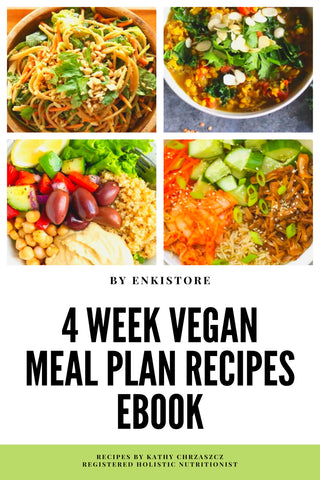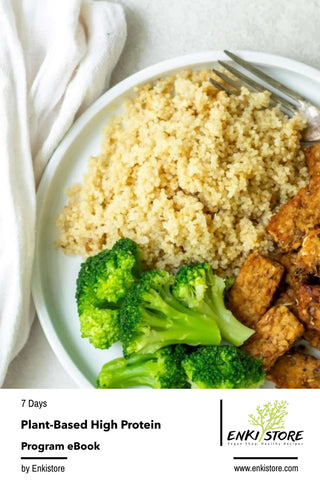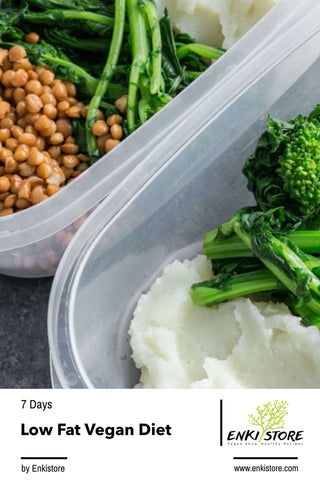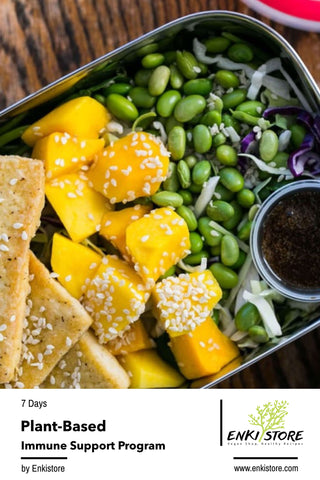The Ultimate Low Fat Vegan Meal Prep Guide: Step-by-Step Instructions for Success
July 09, 2023
Enki Store
Introduction to the Low Fat Vegan Diet
Transitioning to a low fat vegan diet can be a life-changing decision for many individuals. Not only does it promote overall health and well-being, but it also contributes to a more sustainable and compassionate world. The low fat vegan diet focuses on minimizing the consumption of high-fat foods derived from animal sources while maximizing the intake of nutrient-rich plant-based foods. By following this diet, you can achieve weight loss, reduced risk of chronic diseases, increased energy levels, and improved digestion.
Benefits of a Low Fat Vegan Diet
Embracing a low fat vegan diet offers an array of benefits that positively impact both your body and the environment. Firstly, this diet helps in weight management and promotes a healthy body mass index (BMI). By reducing your intake of high-fat animal products, you naturally consume fewer calories, leading to weight loss and improved overall health.
Additionally, a low fat vegan diet has been shown to lower the risk of developing chronic diseases. Research suggests that a diet rich in plant-based foods reduces the likelihood of heart disease, high blood pressure, type 2 diabetes, and certain types of cancer. The abundance of fiber, vitamins, minerals, and phytochemicals found in plant-based foods contribute to these protective effects.
Moreover, a low fat vegan diet is environmentally sustainable. Animal agriculture is a major contributor to greenhouse gas emissions and deforestation. By choosing plant-based alternatives, you reduce your carbon footprint and help preserve the planet for future generations.
Understanding Macronutrients in a Low Fat Vegan Diet
When following a low fat vegan diet, it is important to understand the macronutrients that make up your meals. Macronutrients refer to carbohydrates, proteins, and fats, which are the essential components of a balanced diet. While a low fat vegan diet primarily focuses on reducing fat intake, it is crucial to ensure an adequate intake of carbohydrates and proteins to support overall health.
Carbohydrates are the primary source of energy for our bodies. Whole grains, legumes, fruits, and vegetables are excellent sources of complex carbohydrates that provide sustained energy throughout the day. Aim to include a variety of these foods in your low fat vegan meal plan to meet your carbohydrate needs.
Proteins are essential for building and repairing tissues, producing enzymes and hormones, and supporting a healthy immune system. Plant-based proteins can be found in beans, lentils, tofu, tempeh, seitan, and edamame. Incorporate a variety of these protein-rich foods into your meals to ensure you are meeting your daily protein requirements.
While a low fat vegan diet focuses on minimizing fat intake, it is important to include healthy fats in moderation. Sources of healthy fats include avocados, nuts, seeds, and plant-based oils. These fats are essential for nutrient absorption, brain function, and hormone production. Be mindful of portion sizes when incorporating fats into your low fat vegan meal plan.
Creating a Low Fat Vegan Meal Plan
A well-structured low fat vegan meal plan is essential for successful adherence to this dietary lifestyle. By planning and preparing your meals in advance, you can save time, reduce stress, and ensure that your nutritional needs are met. Here are some steps to create an effective low fat vegan meal plan:
- Set your goals: Determine your specific health goals, whether it is weight loss, improved energy levels, or enhanced athletic performance. This will help guide the composition of your meal plan.
- Calculate your daily calorie needs: Use an online calorie calculator to determine your daily calorie requirements based on your age, gender, activity level, and weight goals. This will serve as a starting point for designing your low fat vegan meal plan.
- Choose nutrient-dense foods: Opt for whole, unprocessed plant-based foods that are rich in nutrients. Include a variety of fruits, vegetables, whole grains, legumes, and plant-based proteins in your meal plan.
- Practice portion control: Be mindful of portion sizes to avoid overeating. Use measuring cups and a food scale to ensure accurate portioning.
- Plan your meals: Create a weekly meal plan that includes breakfast, lunch, dinner, and snacks. Consider incorporating a balance of carbohydrates, proteins, and healthy fats into each meal.
- Prepare your grocery list: Based on your meal plan, make a comprehensive grocery list to ensure you have all the necessary ingredients on hand.
Step-by-Step Instructions for Low Fat Vegan Meal Prep
Meal prepping is a crucial component of a successful low fat vegan diet. By dedicating a few hours each week to prepare your meals in advance, you can save time, reduce decision fatigue, and ensure that you always have healthy options available. Follow these step-by-step instructions for low fat vegan meal prep:
- Plan your meals: Refer to your weekly meal plan and decide which meals you will be prepping. Consider the number of servings you will need for each meal and adjust the quantities accordingly.
- Choose your recipes: Select low fat vegan recipes that align with your taste preferences and nutritional needs. Look for recipes that can be easily batch-cooked and stored for future consumption.
- Grocery shopping: Refer to your meal plan and recipes to create a comprehensive grocery list. Ensure you have all the necessary ingredients on hand before you start meal prepping.
- Set aside time: Dedicate a specific day and time each week for meal prepping. This will help you establish a routine and ensure you have enough time to prepare and store your meals.
- Batch cook: Start by preparing the components that can be cooked in large batches, such as grains, legumes, and roasted vegetables. Cook them according to your recipe instructions and portion them into individual containers.
- Portion your meals: Once your components are ready, portion them into individual containers based on your meal plan. Ensure you include a balance of carbohydrates, proteins, and vegetables in each container.
- Store and label: Place your prepared meals in airtight containers and label them with the date and contents. This will help you keep track of the freshness of your meals and make meal selection easier throughout the week.
By following these step-by-step instructions for low fat vegan meal prep, you can streamline your mealtime routine and set yourself up for success on your low fat vegan journey.
Essential Kitchen Tools for Low Fat Vegan Meal Prep
Having the right kitchen tools can make the process of low fat vegan meal prep more efficient and enjoyable. Here are some essential tools that every low fat vegan meal prepper should have:
- High-quality chef's knife: A sharp and reliable chef's knife is a must-have for chopping vegetables, fruits, and other ingredients. Invest in a good-quality knife that feels comfortable in your hand and allows for precise cutting.
- Cutting board: Choose a sturdy cutting board that is large enough to comfortably accommodate your ingredients. Opt for a cutting board made of bamboo or wood, as they are gentle on your knife's blade.
- Blender or food processor: A blender or food processor is essential for preparing smoothies, sauces, dressings, and dips. Look for a powerful and versatile blender that can handle a variety of ingredients.
- Baking sheets and pans: Baking sheets and pans are useful for roasting vegetables, baking tofu, and preparing other low fat vegan dishes. Invest in non-stick pans or use parchment paper to prevent sticking.
- Steamer basket: Steaming is a healthy cooking method that helps retain the nutrients in your vegetables. A steamer basket can be placed in a pot or a wok to cook your vegetables to perfection.
- Meal prep containers: Invest in a set of durable and reusable meal prep containers. Look for containers that are microwave-safe, dishwasher-safe, and leak-proof for convenient storage and reheating.
Having these essential kitchen tools on hand will make your low fat vegan meal prep experience more efficient and enjoyable.
Low Fat Vegan Meal Prep Recipes and Ideas
Coming up with creative and delicious low fat vegan meal prep recipes can make your culinary journey exciting and enjoyable. Here are some recipe ideas to inspire your low fat vegan meal prep:
Breakfast:
- Overnight oats with mixed berries and chia seeds
- Tofu scramble with vegetables and whole grain toast
- Green smoothie packed with spinach, banana, and almond milk
Lunch:
- Quinoa salad with roasted vegetables and lemon-tahini dressing
- Lentil soup with a side of mixed greens
- Baked falafel wraps with hummus and fresh vegetables
Dinner:
- Stir-fried tofu and vegetables with brown rice
- Spaghetti squash with marinara sauce and vegan meatballs
- Chickpea curry with basmati rice and steamed broccoli
Snacks:
- Veggie sticks with homemade hummus
- Apple slices with almond butter
- Air-popped popcorn seasoned with nutritional yeast
These recipe ideas serve as a starting point for your low fat vegan meal prep. Feel free to modify and customize them according to your taste preferences and nutritional needs.
Tips for Successful Low Fat Vegan Meal Prep
To ensure a smooth and successful low fat vegan meal prep experience, consider the following tips:
- Start small: If you're new to meal prepping, start with preparing just a few meals in advance to avoid feeling overwhelmed. Gradually increase the number of meals you prep as you become more comfortable with the process.
- Choose versatile ingredients: Opt for ingredients that can be used in multiple recipes. For example, if you are roasting vegetables for one meal, roast extra to use in salads or wraps throughout the week.
- Get creative with spices and seasonings: Experiment with different herbs, spices, and seasonings to add variety and flavor to your meals. This will prevent meal monotony and make your low fat vegan diet more enjoyable.
- Use time-saving techniques: Make use of time-saving techniques, such as batch cooking grains and legumes, pre-chopping vegetables, and using pre-cut frozen fruits and vegetables. This will help reduce prep time and make meal prepping more efficient.
- Stay organized: Keep your kitchen organized by labeling your containers, grouping similar ingredients together, and maintaining a clean workspace. This will make meal prepping a more enjoyable and stress-free experience.
- Store your meals properly: Proper storage is crucial for maintaining the freshness and flavor of your prepped meals. Use airtight containers, refrigerate perishable foods promptly, and freeze meals that you won't be consuming within a few days.
By implementing these tips, you can ensure a successful low fat vegan meal prep routine that supports your health and dietary goals.
Common Challenges and How to Overcome Them in Low Fat Vegan Meal Prep
While low fat vegan meal prep offers numerous benefits, it can also present some challenges. Here are some common challenges you may encounter and tips on how to overcome them:
- Lack of time: Many individuals struggle with finding the time to meal prep. To overcome this challenge, consider dedicating a specific day and time each week for meal prepping. Prioritize this time for your health and make it a non-negotiable part of your routine.
- Limited cooking skills: If you are new to cooking or have limited culinary skills, low fat vegan meal prep may seem daunting. Start with simple recipes and gradually expand your cooking skills by trying new techniques and experimenting with flavors.
- Meal monotony: Eating the same meals repeatedly can lead to meal monotony and reduced motivation. Combat this challenge by incorporating variety into your meal plan. Experiment with new recipes, flavors, and cooking techniques to keep your meals exciting and enjoyable.
- Storage limitations: Limited refrigerator and freezer space can pose a challenge when prepping meals in advance. Maximize your storage space by utilizing stackable containers, freezer-safe bags, and organizing your fridge to accommodate your prepped meals.
- Travel and social events: Traveling or attending social events can disrupt your low fat vegan meal prep routine. Plan ahead by packing portable snacks and researching vegan-friendly restaurants at your destination. If attending social events, consider bringing a low fat vegan dish to share with others.
By being aware of these common challenges and implementing strategies to overcome them, you can maintain a successful low fat vegan meal prep routine even in the face of obstacles.
Resources for Further Support in Low Fat Vegan Meal Prep
Embarking on a low fat vegan journey can be overwhelming at times, but there are numerous resources available to provide support and guidance. Here are some resources that can assist you in your low fat vegan meal prep:
- Cookbooks: Invest in cookbooks specifically focused on low fat vegan recipes. These cookbooks provide a wealth of recipe ideas, cooking techniques, and tips for successful meal prepping.
- Online communities: Join online communities or forums dedicated to low fat vegan meal prep. These communities offer a platform for sharing recipe ideas, asking questions, and seeking support from like-minded individuals.
- Meal planning apps: Utilize meal planning apps that offer low fat vegan meal plans, recipes, and grocery lists. These apps can streamline your meal planning process and provide inspiration for your low fat vegan journey.
- YouTube channels: Explore YouTube channels dedicated to low fat vegan cooking and meal prep. Many content creators share recipe tutorials, meal prep tips, and personal experiences that can provide valuable insights and motivation.
- Registered dietitians: Consult with a registered dietitian who specializes in plant-based nutrition. They can provide personalized guidance, address specific dietary concerns, and ensure you are meeting your nutritional needs on a low fat vegan diet.
By utilizing these resources, you can enhance your knowledge, gain inspiration, and find support throughout your low fat vegan meal prep journey.
Conclusion
Following a low fat vegan diet can have a profound impact on your health, the environment, and animal welfare. By understanding the benefits, macronutrients, and meal planning strategies associated with this dietary lifestyle, you can embark on a successful low fat vegan meal prep journey. Remember to utilize essential kitchen tools, experiment with delicious recipes, and overcome common challenges along the way. With dedication, organization, and support from available resources, you can thrive on a low fat vegan meal plan and experience the numerous benefits it offers. Start your low fat vegan meal prep journey today and reap the rewards of a healthier and more compassionate lifestyle.
CTA: If you're ready to embark on a low fat vegan meal prep journey, start by planning your first week of meals using the step-by-step instructions provided in this guide. Remember, consistency is key, so stick to your meal plan and enjoy the benefits of a low fat vegan lifestyle. Happy meal prepping!
























